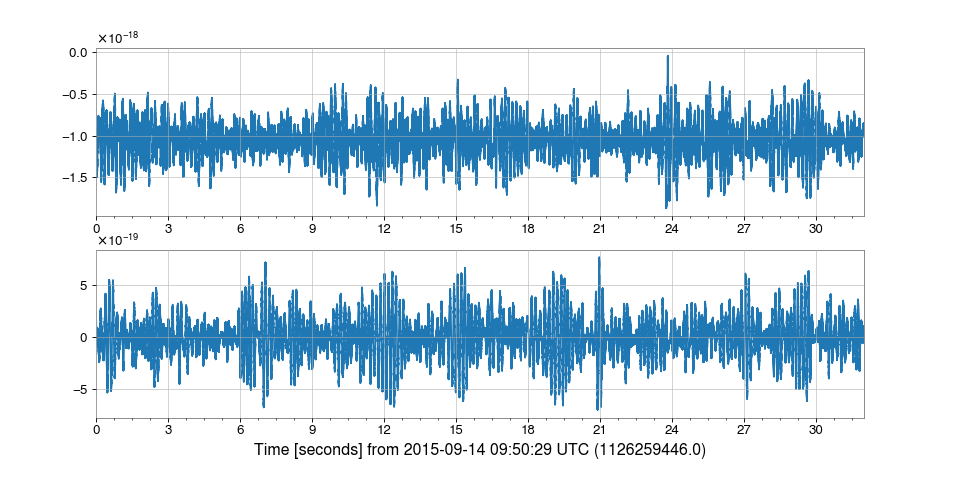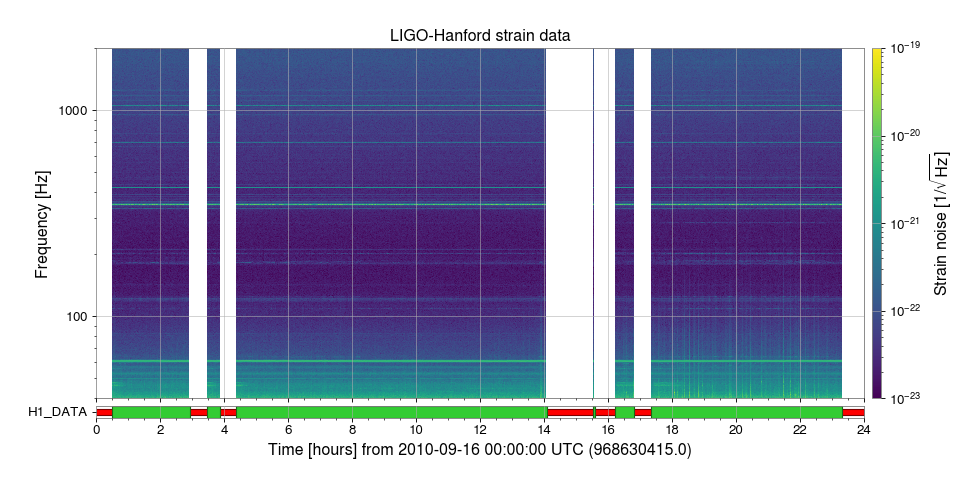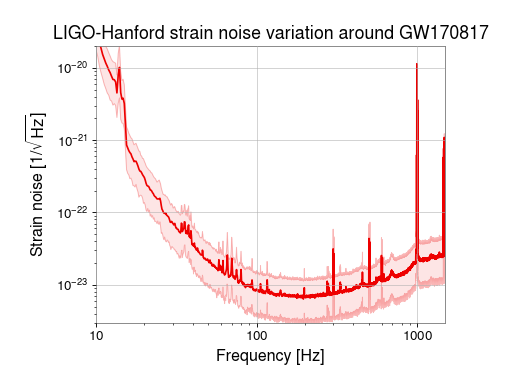|
Size: 509
Comment:
|
Size: 3751
Comment:
|
| Deletions are marked like this. | Additions are marked like this. |
| Line 4: | Line 4: |
| === 複数の時系列を縦に並べてplotする === [[https://gwpy.github.io/docs/stable/timeseries/plot.html#plotting-multiple-timeseries-together|ここ]]に書いてある、gwpy.plotのPlot()がオススメ。<<BR>> 注意点は、TimeSeriesのlistやTimeSeriesDictを引数にしてまとめて渡した場合は ''separate=True'' をしても分割されないという謎仕様。面倒だが1つ1つ手で並べる必要がある。 {{{#!python from gwpy.plot import Plot plot = Plot(l1hoft, h1hoft) plot = Plot(l1hoft, h1hoft, separate=True, sharex=True) plot.show() }}} {{https://gwpy.github.io/docs/stable/_images/plot-7.png}} 戻り値 (ここでは ''plot'')は、[[https://matplotlib.org/3.2.1/api/_as_gen/matplotlib.pyplot.figure.html|matplotlibのfigure]]だと思ってしまってよい。<<BR>> なので、それぞれのy軸ラベルや全体のタイトルを付けるには以下のようにする。 {{{#!python import matplotlib.pyplot as plt axes = plot.get_axes() ylabel = ['y1','y2'] for i, ax in enumerate(axes): ax.set_ylabel(ylabel[i]) plt.tight_layout() plt.subplots_adjust(top=0.95) plot.suptitle('title') }}} === 時刻の基準を手で設定する === [[https://gwpy.github.io/docs/stable/timeseries/plot.html#plotting-multiple-timeseries-together|ここ]]を参照 {{{#!python ax = plot.gca() ax.set_epoch(1126259462) # GPS timeを入れる }}} |
|
| Line 6: | Line 36: |
''.add_segments_bar()'' を使う([[https://gwpy.github.io/docs/latest/examples/miscellaneous/open-data-spectrogram.html|ここ]]を参照)。 |
''.add_segments_bar()'' を使う([[https://gwpy.github.io/docs/latest/examples/miscellaneous/open-data-spectrogram.html|ここ]]を参照)。<<BR>> 他にも ''.add_state_segments()'' や ''.add_dataqualityflag()'' といった似たものがある。詳細は[[https://gwpy.github.io/docs/latest/plotter/api.html#gwpy.plotter.Plot.add_line|Plotting API]]を参照。 |
| Line 12: | Line 41: |
| 他にも ''.add_state_segments()'' や ''.add_dataqualityflag()'' といった似たものがある。詳細は[[https://gwpy.github.io/docs/latest/plotter/api.html#gwpy.plotter.Plot.add_line|Plotting API]]を参照。 | === スペクトルのパーセンタイル/σバンドを付ける === [[https://gwpy.github.io/docs/stable/examples/frequencyseries/percentiles.html|ここ]]を参照。手順としては、 1. まずTimeSeriesから[[https://gwpy.github.io/docs/stable/api/gwpy.timeseries.TimeSeries.html#gwpy.timeseries.TimeSeries.spectrogram2|spectrogram2()]]を使ってnon-averaged power Spectrogramを作る。 2. .percentile() でパーセンタイルのスペクトルを3つ作る。 3. plot_mmm() で描画するとバンド付きでplotされる。 {{{#!python from gwpy.timeseries import TimeSeries from gwpy.plot import Plot hoft = TimeSeries. ... sg = hoft.spectrogram2(fftlength=4, overlap=2, window='hanning') ** (1/2.) median = sg.percentile(50) low = sg.percentile(5) high = sg.percentile(95) plot = Plot() ax = plot.gca(xscale='log', xlim=(10, 1500), xlabel='Frequency [Hz]', yscale='log', ylim=(3e-24, 2e-20), ylabel=r'Strain noise [1/$\sqrt{\mathrm{Hz}}$]') ax.plot_mmm(median, low, high, color='gwpy:ligo-hanford') ax.set_title('LIGO-Hanford strain noise variation around GW170817', fontsize=16) plot.show() }}} {{https://gwpy.github.io/docs/stable/_images/percentiles-4.png}} パーセンタイルではなくmeanとσで表したい場合は、Spectrogramの2次元配列に対して時間軸(0軸)方向にmean, stdを取ればよい。 {{{#!python mean = FrequencySeries(data=sg.mean(0), frequencies=SG.frequencies) sigma = FrequencySeries(data=sg.std(0), frequencies=SG.frequencies) }}} == matplotlib色々 == [[https://qiita.com/simonritchie/items/da54ff0879ad8155f441|プロットの複雑なレイアウトはGridSpecが便利かも、という話]] [[https://bunseki-train.com/axvspan-and-axhspan/|matplotlibで一定区間に背景色をつける方法]] |
Plotの描画関連
複数の時系列を縦に並べてplotする
ここに書いてある、gwpy.plotのPlot()がオススメ。
注意点は、TimeSeriesのlistやTimeSeriesDictを引数にしてまとめて渡した場合は separate=True をしても分割されないという謎仕様。面倒だが1つ1つ手で並べる必要がある。

戻り値 (ここでは plot)は、matplotlibのfigureだと思ってしまってよい。
なので、それぞれのy軸ラベルや全体のタイトルを付けるには以下のようにする。
時刻の基準を手で設定する
ここを参照
DQ Flagを添える
.add_segments_bar() を使う(ここを参照)。
他にも .add_state_segments() や .add_dataqualityflag() といった似たものがある。詳細はPlotting APIを参照。

スペクトルのパーセンタイル/σバンドを付ける
ここを参照。手順としては、
まずTimeSeriesからspectrogram2()を使ってnon-averaged power Spectrogramを作る。
- .percentile() でパーセンタイルのスペクトルを3つ作る。
- plot_mmm() で描画するとバンド付きでplotされる。
1 from gwpy.timeseries import TimeSeries
2 from gwpy.plot import Plot
3
4 hoft = TimeSeries. ...
5 sg = hoft.spectrogram2(fftlength=4, overlap=2, window='hanning') ** (1/2.)
6 median = sg.percentile(50)
7 low = sg.percentile(5)
8 high = sg.percentile(95)
9
10 plot = Plot()
11 ax = plot.gca(xscale='log', xlim=(10, 1500), xlabel='Frequency [Hz]', yscale='log', ylim=(3e-24, 2e-20), ylabel=r'Strain noise [1/$\sqrt{\mathrm{Hz}}$]')
12 ax.plot_mmm(median, low, high, color='gwpy:ligo-hanford')
13 ax.set_title('LIGO-Hanford strain noise variation around GW170817', fontsize=16)
14 plot.show()

パーセンタイルではなくmeanとσで表したい場合は、Spectrogramの2次元配列に対して時間軸(0軸)方向にmean, stdを取ればよい。
